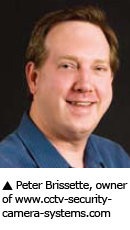Once a school has outlined its needs, how does it find the right solution from a dizzying array of choices? A&S examines what makes a solution pass muster.
Implementing higher education security requires a careful process of evaluation. First, the campus security team identifies a need and secures funding from the administration. This is no easy task, considering the many competing needs for a school’s limited resources.
Once a school has outlined its needs, how does it find the right solution from a dizzying array of choices? A&S examines what makes a solution pass muster.
Implementing higher education security requires a careful process of evaluation. First, the campus security team identifies a need and secures funding from the administration. This is no easy task, considering the many competing needs for a school's limited resources.
Once the expense has been approved, a round of product selection takes place. Not all solutions are the same, requiring the security team to sit down with a consultant to determine their needs. The consultant will make suggestions based on the application, then it comes down to the integrator and manufacturer.
This specification process is by no means set in stone, with schools actively wooed by equipment makers. “With the heightened focus on campus safety, institutions can expect to be approached by numerous suppliers of products and technologies,” said Muriel Runnalls, Marketing Manager for the Public Sector at ADT Fire & Security. “While it may be important to implement certain security and safety enhancements promptly, the decision should be rooted in the larger overall life-safety picture of the campus and its long-term implications.”
“It is paramount that the existing life-safety infrastructure, applicable codes and standards, and overall prot e c t i on goa l s should be analyzed,” Runnalls said. “With all this in mind, higher education establishments can then assess the risks effectively and how these risks will be managed and mitigated. A diligent risk assessment can then guide decision makers to the appropriate solutions, as the results will highlight the main selection criteria for your institution.”
Eyes on the Prize
For Asia, education largely deploys security cameras and metal detectors. “The education vertical is still a key user of analog equipment, but slowly moving to IP,” said Parul Oswal, Industry Analyst, Frost & Sullivan.
 Surveillance applications must be carefully planned. Camera placement will depend on each security scenario, but is driven by the value of what is being protected. “The highest value item is of course people, so most cameras are placed on the perimeter of where the people are,” said Paul Bodell, CMO of IQinVision. “Cameras inside dorms are not very common, but cameras monitoring who is outside the dorms and classrooms and the entrances to dorms and academic buildings are quite common.”
Surveillance applications must be carefully planned. Camera placement will depend on each security scenario, but is driven by the value of what is being protected. “The highest value item is of course people, so most cameras are placed on the perimeter of where the people are,” said Paul Bodell, CMO of IQinVision. “Cameras inside dorms are not very common, but cameras monitoring who is outside the dorms and classrooms and the entrances to dorms and academic buildings are quite common.”
Camera installations must comply with local privacy legislation. “Like any other workplace, school campuses employ video surveillance to help secure and protect staff and students, plus detect and prevent building damage and property theft,” said Ian Scott, VP of Physical Security Group for the U.S., Professional Products, Victor Company of Japan (JVC). “However, schools in particular should make sure security and surveillance systems are installed in plain sight as a visual deterrent against vandalism and other criminal behavior. In addition, any campus video system should provide image quality that is sufficient to identify individuals, and the system should be reliable enough to provide continuous coverage of all common areas.”
 IP video equipment must run natively on the campus' existing network. “Cameras are a maximum of only 5 MB per port, compared to 100 MB from someone on a laptop,” said Wong Wai King, Country Manager for Australia and New Zealand, Axis Communications. “Moreover, Axis cameras are capable of controlling bandwidth utilization from the camera end.” At one urban Australian university, which deploys network cameras on every light post, the video surveillance traffic takes up about 5 to 10 percent of the overall network.
IP video equipment must run natively on the campus' existing network. “Cameras are a maximum of only 5 MB per port, compared to 100 MB from someone on a laptop,” said Wong Wai King, Country Manager for Australia and New Zealand, Axis Communications. “Moreover, Axis cameras are capable of controlling bandwidth utilization from the camera end.” At one urban Australian university, which deploys network cameras on every light post, the video surveillance traffic takes up about 5 to 10 percent of the overall network.
Once the institution has defined its monitoring application, it must find dependable equipment. “One statistic most of our competitors don't like to discuss is mean time between failures, which speaks to the predicted reliability of a piece of equipment,” Scott said. “Rather than cut corners to offer a cheap product, we carefully choose the best individual components and help save the cost and aggravation of sending technicians to investigate problematic cameras on the system.”
Licenses can be another cost, as some manufacturers require annual license fees for each camera.
Identifying Threats
Managing access is a priority for education. Nearly two-thirds of education facilities in the U.S. use access control systems to aid in minimizing threats, said Frost & Sullivan in its survey “2010 US Physical Security Solutions within the Education Areas.”
 A college campus encompasses athletic facilities, lecture halls, museums and isolated areas with potential graffiti issues. Access solutions must be flexible enough to serve all these needs, while working with existing equipment. “Colleges and universities are continually adding new facilities and personnel, and a security system that is built to seamlessly handle that growth is the best choice for these institutions,” said John Moss, CEO of S2 Security.
A college campus encompasses athletic facilities, lecture halls, museums and isolated areas with potential graffiti issues. Access solutions must be flexible enough to serve all these needs, while working with existing equipment. “Colleges and universities are continually adding new facilities and personnel, and a security system that is built to seamlessly handle that growth is the best choice for these institutions,” said John Moss, CEO of S2 Security.
Access solutions must comply with each country's legislation. “The Disability Discrimination Act was amended in 2005 and has significant impact not only in terms of the design of new systems, but also means that many systems may need to be upgraded to ensure compliance,” said the British Security Industry Association in a 2010 education access control guide. “This is of particular importance for educational establishments, as employees, pupils and visitors will all need to have adequate and user-friendly access to the building.”
 Schools primarily focus on video and access control. Intrusion detection systems are not widely adopted and short-term adoption rates are not expected to increase significantly, said Frost & Sullivan in its US survey. With foot traffic at all hours, the rate of false alarms is not worth the investment in intrusion systems.
Schools primarily focus on video and access control. Intrusion detection systems are not widely adopted and short-term adoption rates are not expected to increase significantly, said Frost & Sullivan in its US survey. With foot traffic at all hours, the rate of false alarms is not worth the investment in intrusion systems.
Integration at School
Schools are seeing more IP uptake, thanks to existing IT infrastructure. “IP is being adopted on larger scale campuses in general,” said Peter Brissette, owner of www.cctv-securitycamera- systems.com. “Schools tend to have excellent technology resources and are able to adapt to newer technology more quickly. Almost all the large campus installations with more than 40 cameras in the last two years have been IP installations. They will typically include installing new network cameras and adding video servers to pull existing analog cameras — especially PTZs — into the new IP installation.”
IP has clear benefits, but requires careful planning. “I would venture to say that we sell no system to a school or campus that doesn't sit on a network in some way,” said Grant Copple, US Sales Lead for UTC Fire & Security. “I would also say that we are seeing an increase in the number of system components that touch the network. This reality brings new challenges concerning bandwidth availability and concerns about network security.”
 Cameras with more resolution mean universities can monitor with fewer cameras and save unnecessary expense. “IP-based systems offer significant cost advantages and a more efficient deployment of the system itself,” said Peter Stanton, CCTV Product Marketing Manager, ADT Fire & Security. “The adoption of IP will continue to gather pace while analog systems, particularly in video surveillance, will disappear over the next two to three years.”
Cameras with more resolution mean universities can monitor with fewer cameras and save unnecessary expense. “IP-based systems offer significant cost advantages and a more efficient deployment of the system itself,” said Peter Stanton, CCTV Product Marketing Manager, ADT Fire & Security. “The adoption of IP will continue to gather pace while analog systems, particularly in video surveillance, will disappear over the next two to three years.”
The connectivity of IP is also aiding information and communication technologies. “We have a case in Europe of distance learning, where students can go online to watch classes,” said JP Yang, Manager, Brand Project Deparment, VIVOTEK. “This is an indoor application, where our cameras can be easily integrated.”
An IP backbone enables integration among systems. “University and college systems are often integrated with emergency call stations to provide rapid access to video cameras,” said Gadi Piran, President of OnSSI. Cameras can monitor 24/7, while video analytics can monitor for changes to notify administrators or campus police.
 System integration includes not only electronic security, but parking management, visitor management and guard tours. “We're constantly developing and bringing complete solutions to customers,” said David Benhammou, President of CDVI Group.
System integration includes not only electronic security, but parking management, visitor management and guard tours. “We're constantly developing and bringing complete solutions to customers,” said David Benhammou, President of CDVI Group.
Although security solutions can be installed as free-standing devices, it is logical for most organizations to not only build an integrated system, but to build it from the same existing platform, said Terence Lee, Director of Product Management for APAC, Ingersoll Rand Security Technologies. “This is the most cost-efficient approach, and it helps avoid the technological glitches found with incompatible software or hardware.”
Channel Development
With opportunities in higher education growing, developing this channel involves vendor outreach. Axis invites potential customers to its installations to hear from IT managers and security managers about how its surveillance system works. “We  also speak at seminars for school education, to educate what network video surveillance is all about and how it integrates in the network,” Wong said.
also speak at seminars for school education, to educate what network video surveillance is all about and how it integrates in the network,” Wong said.
VIVOTEK's business development depends on local channel partners. “We go through distributors for products and offer education to consultants,” Yang said. “Each country has unique needs, so we work with local system integrators to develop solutions.”
A dedicated professional support team helps deal with educationspecific needs. “We use the term ‘mass customization,' as we can mass produce but still adjust things,” Yang said. “In this vertical, it is very hard to expect a standard solution to fit everyone.”
Establishing a channel presence requires effective communication skills. “We spend a lot of time in the field listening to the needs of our integration partners,” Moss said. “Securing clientele and solidifying bonds involves a fair amount of relationship and basic channel management.”
Challenges
While schools are no strangers to networking, the reality is that most security solutions are stand-alone. Adopting the latest technology requires a big budget, which is not available for all institutions.
Some universities have a long history and a great deal of existing equipment . “Legacy equipment, in some instances, has become dated and no longer meets the needs of universities,” Runnalls said. “As a result, the education sector is in a period of transition from analog to digital  solutions.”
solutions.”
Financial realities limit the uptake of networked security. “Cost is the major concern for most end users in schools or universities to adopt IP video surveillance,” Oswal said. “While most of them use analog cameras, they don't see enough need to shift to IP-based systems with high initial setup costs. However, international schools, or higher education institutes are showing interest in IP.”
Since security upgrades are expensive, most universities take a phased approach. However, backwards compatibility can become an issue. “The main challenge for schools is how they are able to integrate multiple systems into a complete security system,” Brissette said. “So many projects are done a piece at a time, and only after systems are installed are the difficulties recognized. This is an ongoing challenge for any large-scale project.”
School security has gotten more high-tech, but keeping students safe is still the top priority. As IP-based security systems enable smoother integration, campus operators can respond more quickly, providing a safe environment for learning and growth.